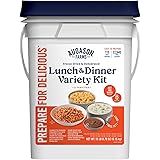Table of Contents
- Introduction
- What Is a Disaster Readiness Kit?
- How to Start Building Your Disaster Readiness Kit
- 7 Effective Tips to Enhance Your Disaster Readiness Kit in 2025
- Conclusion
- Frequently Asked Questions (FAQs)
1. Introduction
In an era where natural and man-made disasters are becoming increasingly unpredictable, having a well-prepared disaster readiness kit is essential for safeguarding yourself and your loved ones. In 2025, the importance of emergency preparedness is more evident than ever, as climate change accelerates the frequency and severity of events like hurricanes, wildfires, and earthquakes. Creating a comprehensive disaster readiness kit ensures you’re ready to respond swiftly and effectively when disaster strikes. This guide will walk you through the top tips to build and maintain an effective kit that provides peace of mind and practical support during emergencies.
Whether you’re new to emergency preparedness or updating your existing kit, understanding what essentials to include and how to adapt to current trends in 2025 is critical. Let’s dive into the key components and strategies to enhance your readiness today.
2. What Is a Disaster Readiness Kit?
Definition and Purpose
A disaster readiness kit is a collection of supplies and tools assembled specifically to sustain individuals and families during emergencies. Its purpose is to provide basic necessities like food, water, shelter, safety, and communication capabilities until help arrives or conditions improve.
In 2025, the scope of a disaster readiness kit has expanded beyond just physical supplies. It now incorporates digital tools, health and safety devices, and customized items based on regional risks. The goal remains the same: ensure resilience and quick response in crisis situations.
== > What if ... Get a FREE Subscription to PREPARE
Why Is It Important?
Having a well-structured disaster readiness kit can be the difference between safety and danger during events like floods, storms, or power outages. It empowers you to act promptly and reduce panic, providing clear guidance and supplies within easy reach.
Recent statistics reveal that over 50% of Americans are unprepared for a major disaster, underscoring the necessity of personal kits. As 2025 witnesses more climate-related disasters, investing in your kit is more crucial than ever.
Legal and Safety Considerations
Some regions have specific mandates regarding disaster preparedness, such as hurricane kits or earthquake supplies. Staying informed about local requirements ensures compliance and safety. Remember to regularly review and update your disaster readiness kit to address changing needs and new threats.
3. How to Start Building Your Disaster Readiness Kit
Assess Regional Risks
The first step is understanding the natural and man-made threats typical of your area. Coastal regions need robust hurricane supplies, while earthquake zones require seismic safety gear. Tailoring your kit to regional risks makes it more effective and practical.
Research recent disaster patterns in your region and consult local emergency services for recommendations. This preparation ensures your disaster readiness kit is relevant and comprehensive.
Gather Essential Supplies
Start by accumulating core items such as food, water, first aid supplies, clothing, and tools. Invest in durable, high-quality items that can withstand prolonged use or harsh conditions. Keep your kit in an accessible location, and consider portable options for evacuation scenarios.
Creating a checklist helps ensure you don’t miss vital supplies. Include water (at least 1 gallon per person per day), non-perishable food, batteries, flashlights, and hygiene products. A well-organized kit prevents chaos in emergencies.
Plan for Family Needs
Each family member may have specific needs, like medications, medical devices, or infants’ supplies. Personalize your kit to accommodate these requirements for optimal safety and comfort.
Also, consider including important documents, emergency contacts, and communication devices. A comprehensive starting point helps build confidence before emergencies occur.
4. 7 Effective Tips to Enhance Your Disaster Readiness Kit in 2025
1. Incorporate Modern Technology
In 2025, technology plays a pivotal role in disaster preparedness. Include portable chargers, solar-powered devices, and communication tools like walkie-talkies or satellite phones. These help maintain contact when traditional networks fail.
Apps for emergency alerts, weather updates, and first aid instructions can also be integrated into your preparedness plan. Using tech ensures your disaster readiness kit remains versatile and up-to-date.
2. Focus on Sustainability and Eco-Friendliness
Opt for reusable and environmentally friendly supplies. Consider solar-powered lanterns, biodegradable hygiene products, and refillable water bottles. Reducing waste and dependence on disposable items enhances preparedness sustainability.
In 2025, eco-conscious choices contribute to community resilience and environmental health, making your kit more responsible and reliable.
Get Preparedness and Self-Reliance Tips. Subscribe Now!Â
3. Include Mental and Emotional Support Items
Disasters are stressful; including items like stress-relief tools, comforting objects, and advance books can ease anxiety. Additionally, downloading calming apps or audio recordings can be helpful during prolonged crises.
A resilient disaster readiness kit considers mental health as much as physical supplies, supporting emotional stability amid chaos.
4. Regularly Update and Rotate Supplies
Create a schedule for checking expiration dates on food, medications, batteries, and other perishables. Regular updates ensure your kit remains fully operational and ready to use.
Set reminders to review your kit at least bi-annually, and replace expired items promptly. Stale supplies or missing items compromise effectiveness.
5. Customize for Regional Climate and Disasters
Adjust your kit based on local weather phenomenaâcold weather supplies for winter storms, water purification for flood-prone areas, or fire-resistant gear in wildfire zones.
Being region-specific increases your chances of survival and comfort during emergencies in 2025.
6. Train and Prepare Your Family
Ensure that all family members know the contents of the disaster readiness kit and how to use them. Conduct regular drills to improve response times and reduce panic.
Understanding your kit’s features boosts confidence and readiness for real-world scenarios.
7. Partner with Local Emergency Services
Establish connections with local agencies for guidance and support. They may offer checklists, training, or community programs to enhance your preparedness.
Participation in community preparedness initiatives can boost your disaster readiness kitâs effectiveness and your overall resilience.
5. Conclusion
Building a comprehensive disaster readiness kit is a fundamental step towards safety and resilience in 2025. As natural disasters grow more frequent and intense, being prepared with the right supplies and strategies can make all the difference. Remember, a well-maintained and customized kit tailored to your regional risks ensures you’re equipped to handle emergencies confidently.
Start today by assessing your needs, gathering essentials, and incorporating modern and sustainable solutions. Stay proactive, and your disaster readiness kit will be a vital lifeline when it matters most.
Frequently Asked Questions (FAQs)
1. What should be included in a disaster readiness kit for 2025?
Your disaster readiness kit should include essentials like water, non-perishable food, first aid supplies, flashlight, batteries, personal hygiene items, important documents, medications, and communication devices. Tailor items based on regional risks and family needs for optimal preparedness.
2. How often should I update my disaster readiness kit?
Itâs recommended to review and update your disaster readiness kit at least twice a year. Check expiration dates on food, batteries, and medications, and replace any worn or expired items. Regular updates ensure your kit remains functional and ready for use.
3. Why is a disaster readiness kit important in 2025?
With the increasing frequency of climate-related events and other emergencies in 2025, having a disaster readiness kit is crucial for survival and comfort during crises. It provides peace of mind and enhances your ability to respond swiftly and effectively.
4. How can I personalize my disaster readiness kit?
Personalize your kit by including specific items needed for family members, such as medications or special supplies. Also, adapt your kit to regional threats like wildfire gear or cold-weather supplies to maximize safety and effectiveness.






